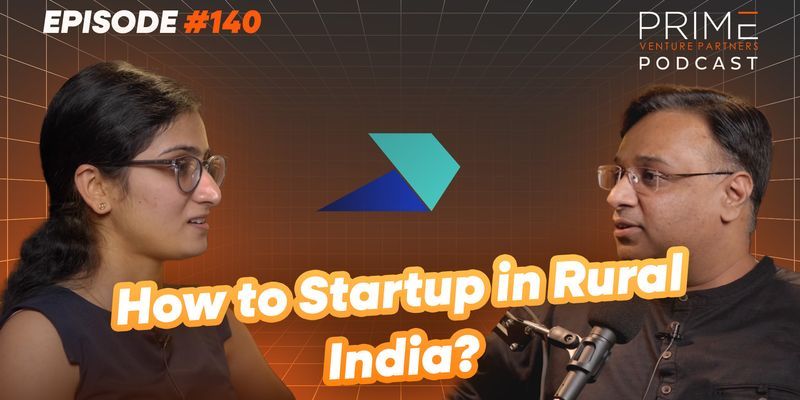
Navadhan Capital is a tech-led financing platform for rural small and medium enterprises (SMEs). The startup delivers multiple credit products to meet varied credit needs based on cash flows—linked to seasonality and peculiarities of micro-markets.
Nitin Agarwal, the Founder and CEO of Navadhan Capital, is a seasoned business leader with over 20 years of experience in institutions catering to rural India. He graduated from the Institute of Rural Management, Anand (IRMA), worked across microfinance and financial services institutions, and in his last role, he was the CEO of microfinance company Spandana Spoorthy.
India’s rural economy contributes to about 50% of the GDP and supports nearly 65% of our population.
In a podcast with Prime Venture Partners, Agarwal deep dives into the opportunities in rural India for startups, and highlights how an entrepreneur can go about building for this segment.
<div class="externalHtml embed" contenteditable="false" data-val="”>
.thumbnailWrapper{
width:6.62rem !important;
}
.alsoReadTitleImage{
min-width: 81px !important;
min-height: 81px !important;
}
.alsoReadMainTitleText{
font-size: 14px !important;
line-height: 20px !important;
}
.alsoReadHeadText{
font-size: 24px !important;
line-height: 20px !important;
}
}

Humble beginnings
“I had the privilege of growing up in a very lower-middle-class family,” Agarwal says. Hailing from a Tier II city, Meerut in Uttar Pradesh, he believes the key to his success lies in his upbringing, and the culture of hustle his father embodied by working in multiple jobs.
Even during his school days, Agarwal speaks about how he and his siblings helped their parents with multiple jobs—be it their tuition centre at home or any other trades.
“While making my career choice, I was clear I wanted to do something constructive for the society. Not just for myself, but do it for the community at large,” he recalls.
This decision led him to IRMA, enabling his highly fulfilling career in community leadership spanning over two decades across The Times of India, ICICI Bank, Amul, and Spandana Sphoorty Financial Ltd, among others.
Insights about rural India
“In rural households, cattle are sources of livelihood, liquid assets, and an integral part of the lifestyle. A buffalo today will cost around Rs 1 lakh, and a rural family will decide if they need to buy one buffalo or nine goats at that price,” he says.
Interestingly, a ratio used to evaluate a rural household to issue credit is the number of adults in the household versus the number of working potential people in the household versus the cattle they have in the household. He specifies that anyone above the age of eight and below 80 is considered productive labour.
In the last 20 years, “I have been travelling extensively in rural areas and spending time across the country. It’s a beautiful growth journey, and most definitely, the quality of life has gone up considerably,” he says, adding that the lack of potable water and irregular electricity in many parts of India are the big challenges.
Agarwal agrees that the biggest change has happened because of the ‘JAM Trinity (Jan Dhan Yojana, Aadhar, and Mobile). To support this claim, he says between 2019 and 2023, smartphone penetration in rural areas has shot up from 10% to 40%—a remarkable shift that will propel the economic landscape of rural India.
.thumbnailWrapper{
width:6.62rem !important;
}
.alsoReadTitleImage{
min-width: 81px !important;
min-height: 81px !important;
}
.alsoReadMainTitleText{
font-size: 14px !important;
line-height: 20px !important;
}
.alsoReadHeadText{
font-size: 24px !important;
line-height: 20px !important;
}
}

The ‘Bharat’ opportunity
“I think the opportunity set is massive; rural is ready to explode… People haven’t even scratched the surface. The opportunity set is big. The sheer size of the population, the GDP growth potential that rural markets have, and the scale of informality in these economies becoming slightly formalised and eventually coming to the mainstream is massive. I can’t even put a number to it,” he says.
“They should fall in love with the segment and with the space, or else they will find it frustrating,” says Agarwal as a word of caution for anyone interested in working for rural India.
To identify problem areas to be solved, Agarwal says, go onto the field, travel across, and deeply study what is not working. As an example, he says, banking is still not working, and there are a ton of opportunities for startups to build and create large-scale impact.
“There is a whole lot of interesting stuff happening in rural India,… which is not on Google, not on the Internet, Facebook, or Insta,” he says, adding, “But it most definitely is happening!”
Timestamps:
0:00 – Opportunities in rural India
11:24 – Evolution of rural finance and livelihoods
20:03 – Rural tech transformation and opportunities
32:45 – Building a tech-led scale-up business
45:32 – Parenting and tech
Edited by Suman Singh










